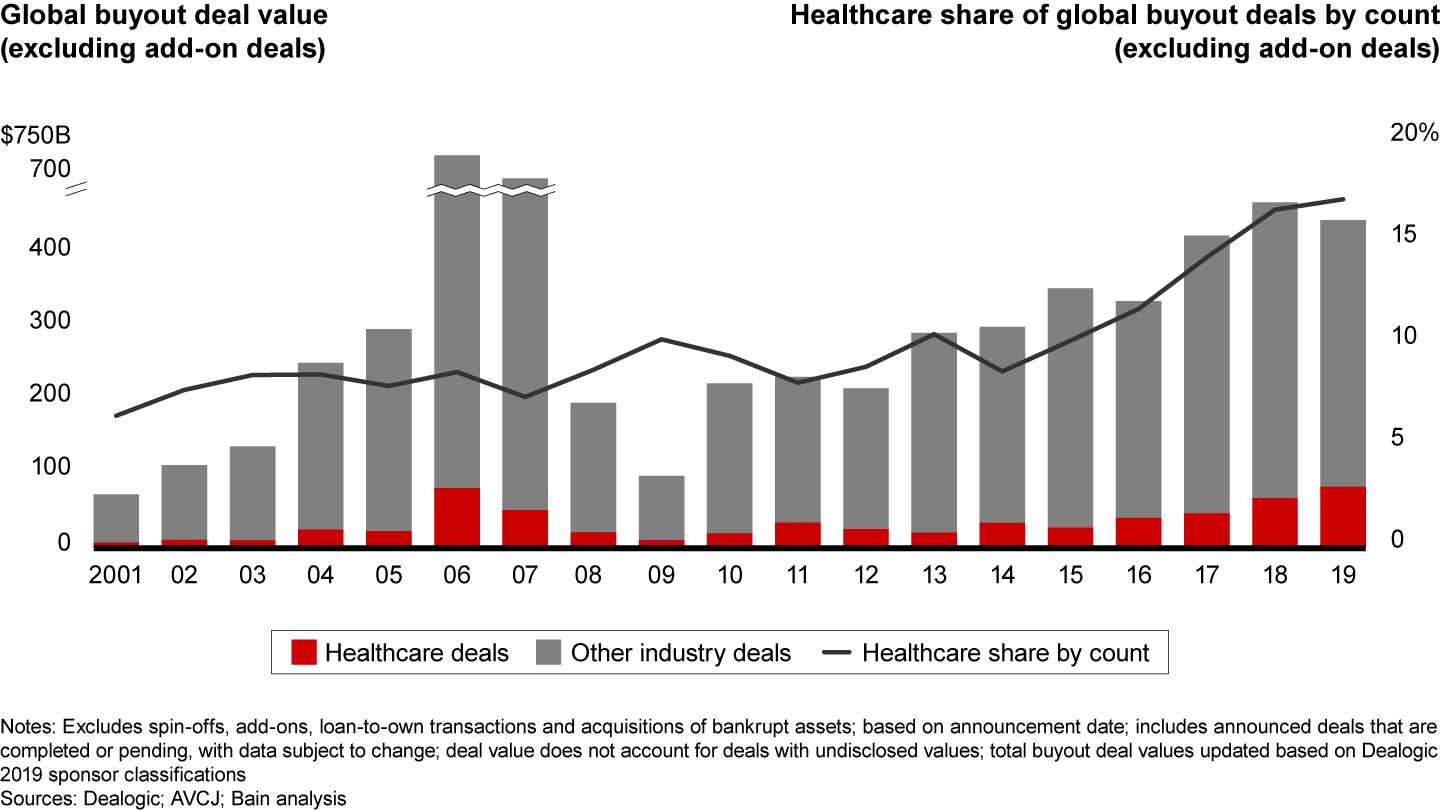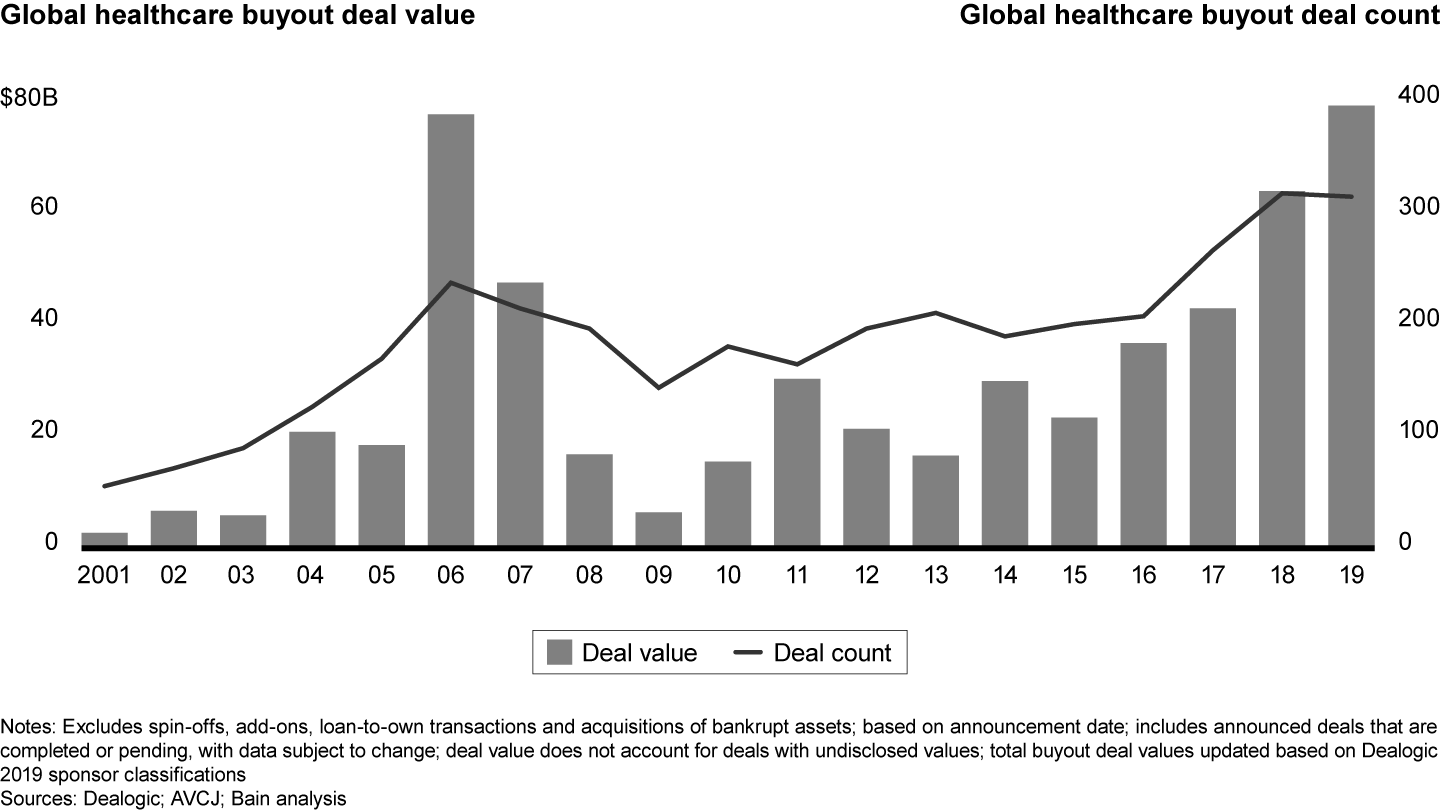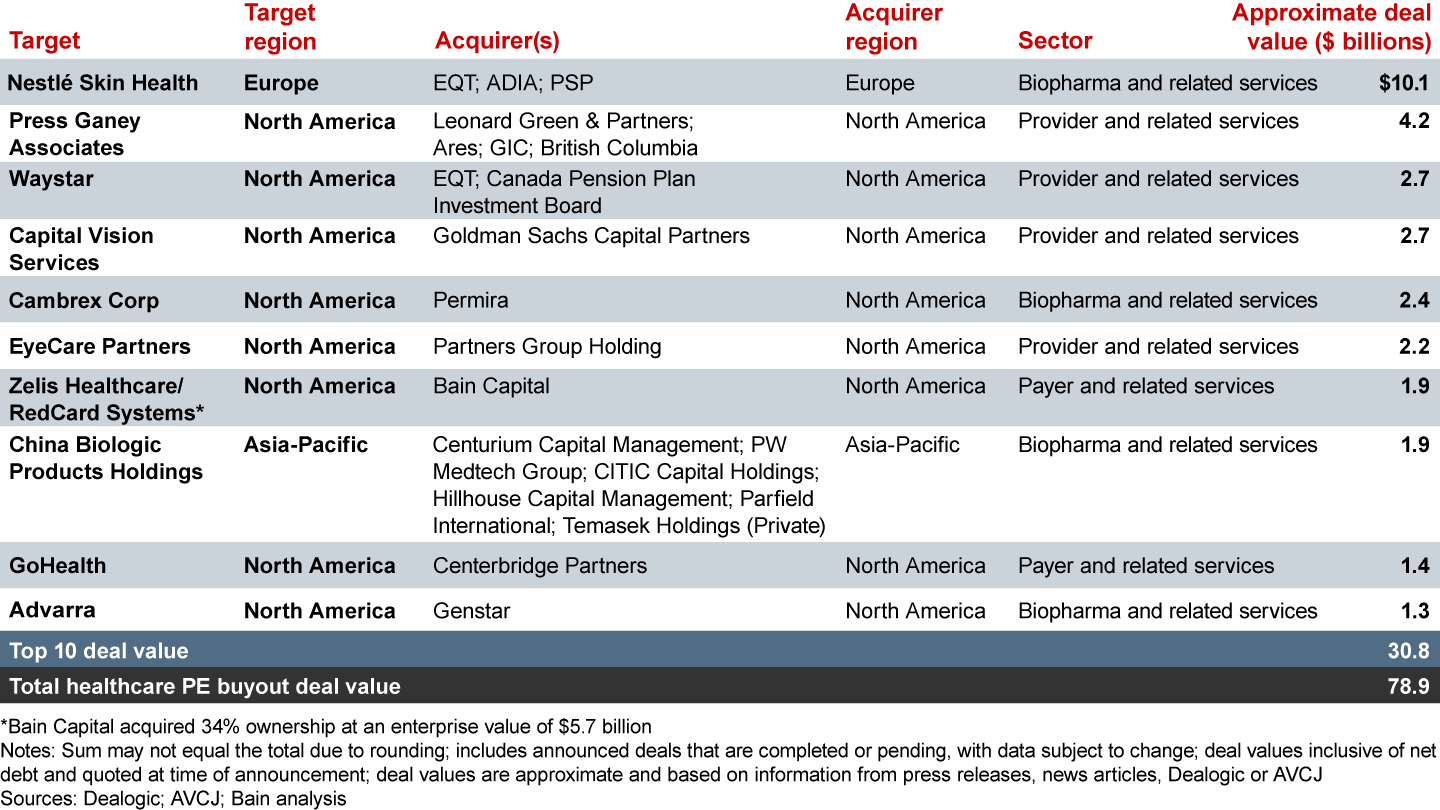Report

At a Glance
- Healthcare private equity activity in 2019 posted a very strong performance relative to the prior year. Total disclosed deal value reached $78.9 billion, the highest on record, and the deal count of 313 was in line with the 316 deals of 2018.
- The average deal size rose roughly 25% as funds focused more on larger assets. There were 27 deals greater than $1 billion in value in 2019, compared with 18 such deals in 2018.
- Consistent with most of the past two decades, North America remains the most active region, and provider and related services the most active sector.
- Biopharma had an exceptional year as disclosed value grew 146% to $40.7 billion. HCIT across sectors also excelled, with value doubling to $17.5 billion.
This article is part of Bain’s 2020 Global Healthcare Private Equity and Corporate M&A Report. Explore the contents of the report here or download the PDF to read the full report.
Private equity fended off macroeconomic risks in 2019 to log another solid performance, and healthcare in particular expanded its share of overall deal activity.
For all of private equity, a growing consensus expects a global recession in the near future. Geopolitical conditions ranked as the second-highest concern on average for PE fund general partners (GPs) worldwide, behind overheated asset valuations, a recent Preqin survey found. Yet despite a less favorable macro environment, global buyout deal value reached $444 billion, lagging 2018 but on par with the past five years. The number of buyout deals, meanwhile, remained flat at roughly 1,800 (excluding add-ons).
Healthcare private equity, however, had another banner year. It outperformed the broader PE market, representing 18% of all disclosed deal value, up from 14% in 2018 (see Figure 1). There were 313 healthcare deals in 2019, totaling $78.9 billion in disclosed value (see Figure 2).


The average deal size rose roughly 25% in healthcare, as funds turned to larger assets with 27 deals greater than $1 billion in value in 2019 compared with 18 such deals in 2018, including the largest buyout in at least the past decade: the $10.1 billion acquisition of Nestlé Skin Health by EQT and Abu Dhabi Investment Authority (ADIA) (see Figure 3). Larger deals signal investor confidence in putting a greater share of the portfolio in healthcare assets. By contrast, in the broader PE market the average size dropped for the first time since 2014. GPs closed fewer megadeals across all of private equity due to stiff competition and rising asset prices.

Several factors account for the industry’s durable investment performance, notably strong underlying demand for healthcare. This comes from an aging global population, a growing incidence and treatment of chronic disease, and rising incomes in emerging markets. In addition, the levels of dry powder, or uncalled capital, keep mounting and must go to work. More PE funds are investing in healthcare, and more individual funds are trying to allocate more of their capital to healthcare. Given how healthcare’s performance held up during the past recession, limited partners (LPs) view healthcare as resilient at any stage of an economic cycle and thus an increasingly attractive area for their capital, as referenced in our report last year. According to Bain & Company analysis in an exclusive partnership with CEPRES, North American healthcare PE investments made during the past recession had a multiple on invested capital (MOIC) nearly 50% higher than other sectors.
Moreover, 2020 Bain research shows that US healthcare industry profit pools will grow at a 5% annual clip over the next five years. Rising disease rates, new innovative therapies, increased enrollment in Medicare Advantage and continued (though slowing) growth in pricing will more than offset ongoing government reimbursement pressures and consolidation in some sectors.
Along with deal activity, healthcare exits also posted a banner year. Disclosed deal values rose 29% to $40.8 billion and count rose 13% to 126.
In the adjacent field of corporate M&A, deal value rose roughly 24% in 2019 on the back of two megadeals: Bristol-Myers Squibb’s acquisition of Celgene for $97 billion and AbbVie’s purchase of Allergan for $85 billion (both deals included net debt).
As in past years, corporates used M&A to build their core capabilities and place option bets on potential disrupters in their respective industries, while simultaneously divesting underperforming and noncore assets.
This proved to be a mixed blessing for PE investors. While corporate acquirers can create intense competition for assets, they also can serve as partners to PE investors that thereby gain access to highly valued assets. Corporates come with a set of complementary capabilities.
Deal activity showed some regional divergence in 2019. North American activity rose modestly, and disclosed value jumped to $46.7 billion, compared with $29.6 billion in 2018. In Europe, volume stayed relatively flat while disclosed value rose about 11% to a new high of $19.7 billion, boosted by the $10.1 billion Nestlé Skin Health acquisition.
Upward movement in those regions was partially offset by a decline in Asia-Pacific volume due to declining activity in China; however, disclosed value in the region was still over 60% above its five-year average, reaching the second-highest level since the most recent recession.
Across regions, we saw a few significant trends during the year, including the following:
- higher valuations prompting creative deal angles;
- biopharma rapidly gaining popularity;
- HCIT rising in popularity across sectors; and
- an increased appetite for select healthcare-heavy assets, along with pipeline risk in life sciences.
Bain's Nirad Jain discusses how healthcare remains one of the hottest sectors in private equity investment, especially during times of macroeconomic uncertainty.
Higher valuations prompt creative deal angles
Competition for high-quality assets has intensified, pushing valuations steadily higher. Both financial sponsors and corporate acquirers had to get more creative in gaining access to deals and then figuring out how to generate outsize returns. Financial sponsors used a range of creative deal approaches, including partnering, looking to public markets, maintaining minority positions in investments and expanding their value-creation theses.
Take partnering: In 2019, half of the deals valued over $1 billion included a consortium of financial sponsors or a corporate partner. For example, a consortium led by Leonard Green & Partners and Ares Management Corporation acquired Press Ganey Associates, the industry leader in patient surveys, for $4.2 billion.
Buyout funds also retained minority interests in assets upon exiting, allowing these funds to lock in a portion of gains at current valuations while also maintaining access to continued upside. TA Associates maintained a minority stake in Aldevron, which it sold to EQT.
To ensure returns in the face of high valuations, more investors determined that they should no longer depend on multiple expansion, and must design more robust value-creation plans. Their levers range from buy-and-build, to buy-and-merge, to commercial excellence tactics that will grow organic sales. One indication of PE firms’ sharper focus on value creation has been the record demand for operating partners, reported by executive search firm Heidrick & Struggles.
Biopharma
When we look across sectors, nearly all of the increase in deal value came in biopharma and related services. The sector rose by $24.2 billion, including major deals such as the Nestlé Skin Health carve-out and also a number of others over $1 billion, such as Advarra and China Biologic Products Holdings. Products, services and HCIT supporting R&D and commercialization efforts of drugmakers continue to be of highest interest, but early-stage technology investment also continues to grow.
HCIT
HCIT has doubled in value since 2018, rising by roughly $9 billion to $17.5 billion. Investors were especially excited about HCIT tied to payers (as illustrated by the Zelis Healthcare/RedCard Systems investment) and biopharma (such as eResearch Technology, or ERT), in addition to ongoing interest in provider IT (such as Waystar).
It’s clear that HCIT has advanced to a new stage. Whereas it once involved narrower activities, like adoption of electronic medical records, now companies apply IT to reduce complexity, contain costs and fuel innovation throughout the system. Data and analytics have become prominent, as two notable deals of the year involved companies that create and compile data for customers—Definitive Healthcare and Press Ganey.
Taking on risks
Investors showed more appetite for taking on reimbursement risk and pipeline risk. More funds focused on niches such as behavioral health and home/hospice care, where they aim to develop category leadership or realize efficiencies through consolidation.
Large buyout firms continued to show interest in healthcare-heavy assets. For instance, TPG raised $2.6 billion—the largest pool of capital dedicated to healthcare buyouts—and quickly deployed that capital into businesses on the front line of care delivery, like Kelsey-Seybold Clinic, a multispecialty, risk-bearing physician group and Medicare Advantage plan.
As for pipeline risk, life sciences, which typically involve early-stage risk, also proved hot during the year. For instance, Blackstone Life Sciences partnered with Novartis to create Anthos Therapeutics, a biopharma company dedicated to developing therapies for cardiovascular disease.
This article is part of Bain’s 2020 Global Healthcare Private Equity and Corporate M&A Report. Explore the contents of the report here or download the PDF to read the full report.



